 |
| |
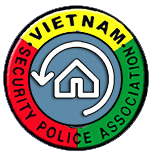 |
Tan Son
Nhut Air Base
Tan
Son Nhut Air Base
Tet 1968
O51 Bunker
Views From The Past, 1998!

|
 |
|
| |
by Frank Ybarbo
377th Combat SPS
1967-1968
© 1999 |
Like many before me, I served in Vietnam exactly thirty (30) years ago in 1967-1968. My tour of duty was strictly at Tan Son Nhut Air Base, located on the north-western edge of Saigon. I know many of you remember this base, especially Air Force Security Policemen who were there with me during the 1968 Tet Offensive. As you may recall, during the Tet attack in the early morning hours of January 31, 1968 we lost four good men (Sergeants Cyr, William J., Fischer, Louis H., Hebron, Charles E., and Mills, Roger B. all Awarded the Silver Star) in the O51 Bunker (Echo 37) which was located on the western perimeter of Tan Son Nhut Air Base and took the brunt of the enemy battalions. Without exaggeration, the five Security Policemen (including Sgt Alonzo Coggins who survived!) in the bunker and the 377th SPS fought gallantly against overwhelming odds. In my mind, I can still hear O51 Bunker's frantic radio transmissions for help as tracer fire, flares and rockets lit up the night sky.
Recently (December 1998), I had the fortunate opportunity to return to Saigon. During my visit I made it a point to see Tan Son Nhut Air Base one more time and try to locate the area of the O51 Bunker. Believe it or not, O51 is still standing. With the help of some excellent Vietnamese guides (Tung and Hoai) we located the bunker. O51 Bunker is the only bunker still there. The original barbed wire perimeter of the airport has been replaced with a twelve (12) foot concrete wall. Highway One (also still there) is a bustling, busy two lane thoroughfare. |
 |
At first, because of all the area improvements and the concrete security wall, I could not locate the exact area of the O51 Bunker which sat approximately forty (40) meters east of Highway One. As we were searching down Highway One I just "happened" to see the roof of a what appeared to be an old bunker protruding above the concrete wall! With the assistance of the two Vietnamese guides I was able to get to the area and to the top of the wall to get a view of the lone, overgrown, standing monument. It was the O51 !
For a moment, all I could do was stare in amazement. I couldn't believe it was still there! As I stared and recalled the battle, it seemed to just stand silent... alone... as a reminder of the acrifices of war. |
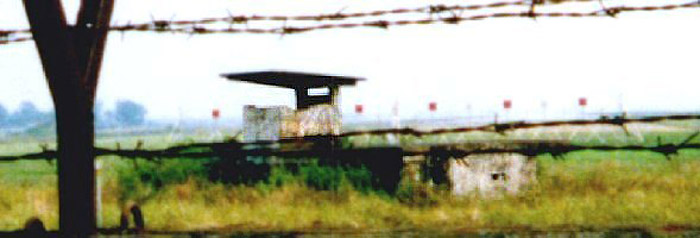
Close up of O51 Bunker, TSN, 1998
|
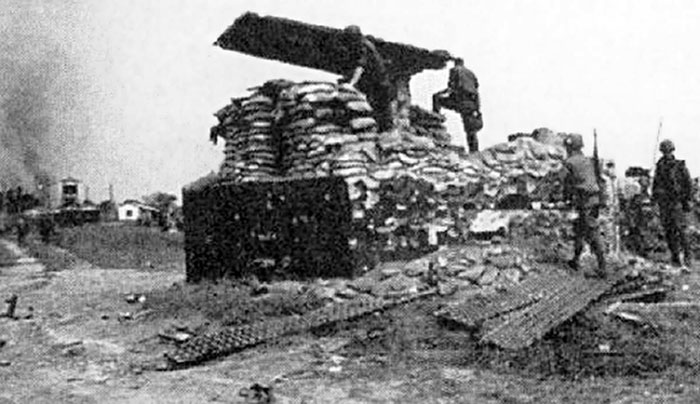
O51 Bunker, 1968, USAF Security Police, after battle for Tan Son Nhut
(Viewed almost from the same angle as above)
|
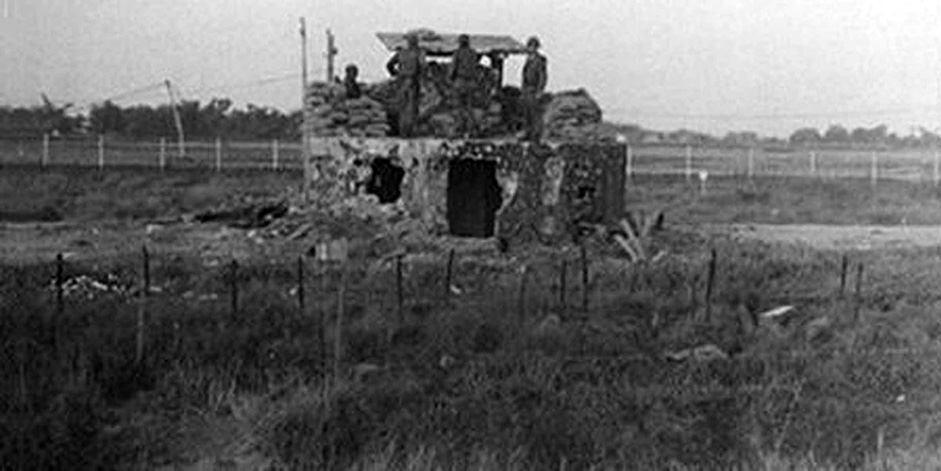
(O51 Bunker as viewed from the rear. Concrete is heavily pock-marked after being overrun by NVA/VC, and then recaptured by Air Force Security Police)
|
The area across Highway One which used to be an open kill zone with just a few dwellings and rice paddies is now built up with businesses all along the highway. The old Vinatexco Factory, from which the Viet Cong staged their attack, is also still there but now operates under a different name.
Much of the Air Base flight line looks the same as it did in 1968. Most of the revetments have been removed and replaced with concrete canopies which are still there and are visible from the terminal. The original aircraft Control Tower, adjacent to the old C-130 and terminal is still in use today. The original airport terminal has been remodeled on the inside, but looks the same on the flight line side as it did in 1968. The front side of the terminal has also been remodeled; however, I was able to clearly recognize the area as it was in 1968.
The original main gate to the base has been removed and the main gate area along the main gate road, which led west to the SP barracks, MARS station and heliport, is now open and a commercial business area. Tan Son Nhut has been down sized and the perimeter moved about two hundred yards to the north of the main gate road. The two large octagon water towers east of the old SP barracks are still there. These towers helped me recognize the area. Many may recall the area just outside the main gate referred to as "100 P Alley". This area of buildings is also still there. In consideration of my Biên Hòa counterparts, I traveled to Biên Hòa in hopes of photographing the Bunker Hill-10, and the Air Base where Capt Reginald Maisey (Air Force Cross) and KIA A1C Edward Muse (K-9) were both killed in action that Tet night. However, after the ride there, photographs were not allowed anywhere around the base area. The highway to Biên Hòa from Saigon and the Biên Hòa area are now all built up with very little country side. Saigon still looks much the same as it did in 1968, but is much more crowded. You can see some modernization and building improvements and such things as cell-phones street phone booths, fax machines, photocopy centers and, believe it or not, the "yellow pages". Anyone desiring to return need not have any anxiety or concern about the trip. The Vietnamese people are friendly and have no animosity toward Americans. The city was safe and relatively inexpensive. Western influence is very much alive and English is still widely accepted and spoken. Although the official name of the city is Hô Chi Minh, everyone continues to call it Saigon. "Again", one thing this trip taught me was "God Bless America And Her People". We are a really blessed nation. I feel more proud now that I had the opportunity to defend our way and assist the Vietnamese people. To me, the trip was well worth it.
Frank Ybarbo,
USAF, 7th Air Force,
377th SPS
Tan Son Nhut Air Base, Vietnam, 1967-1968
"PROVEN IN COMBAT" |
| |
Sgt Alonzo J. Coggins, O51 Bunker survivor, who was severely wounded and medevaced immediately out of Vietnam, has been located and will receive the Silver Star (awarded but never received) in Feb 1999, at Lackland AFB, Texas!
Watch for Sgt Coggins' story here at VSPA!
|
Recommended reading is a book called "The Battle for Saigon" which really tells the Air Force SPS's side of the battle! Excerpts follow:
|
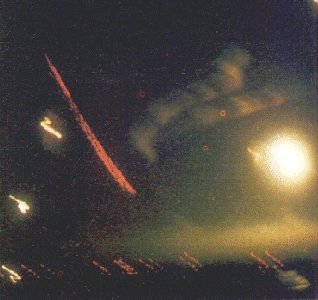 "The attack force (against TSN AB) numbered 2,665 VC and NVA. The 350-man 269th F Battalion spearheaded the attack on the O51 Gate Bunker... the 267h MF Battalion and the 1st Battalion, 271st Regiment were in column formation behind it. The attack was 'on a very narrow front,' noted a U.S. after-action report. The lead battalion's mission was to effect a (base perimeter) penetration, the second battalion in the line was to exploit the penetration, and the third battalion in line was to destroy the equipment and facilities of TSN...." "The attack force (against TSN AB) numbered 2,665 VC and NVA. The 350-man 269th F Battalion spearheaded the attack on the O51 Gate Bunker... the 267h MF Battalion and the 1st Battalion, 271st Regiment were in column formation behind it. The attack was 'on a very narrow front,' noted a U.S. after-action report. The lead battalion's mission was to effect a (base perimeter) penetration, the second battalion in the line was to exploit the penetration, and the third battalion in line was to destroy the equipment and facilities of TSN...."
Nearly twelve hours after the attack began, the lone survivor of the five men O51 Bunker, Sergeant Alonzo Coggins, was released by the four VC who (still) held the bunker. "... The fire on the bunker came to a screeching halt. It resumed when the delirious, burned, and badly wounded airman proceeded down the perimeter road... the guerrillas did not surrender... (and Tech) Sergeant [Bernard C.] Gifford [Silver Star] of the 377th SPS... peeled off his flak jacket... popped up to hurl a third grenade, which exploded in midair right in the doorway. The O51 Bunker was thus retaken.... Four of the five 377th Security Police at O51 Bunker were KIA. Sgt Coggins, the 5th sentry, was so badly wounded the NVA disregarded him as they spun the post's M60 toward the flight line and opened fire...." The savage storming of O51 Bunker by VC and NVA was temporarily successful, but cost tremendous casualties for the NVA, and ultimate defeat. The valiant defense of O51 Bunker delayed enemy advance and provided time for the 377th's SP Response Team to get in line and block the enemies' flight line attack, which gained time for the 25ths' arrival. When O51 Bunker was overrun, firing was so intense from the captured bunker that base defenders asked and received permission to fire on the bunker, as everyone assumed the five SPs were dead. The concrete bunker, with Sgt Coggins inside and very much alive, was hit several times.
Don Poss |
| |
| |
|
|







 "The attack force (against TSN AB) numbered 2,665 VC and NVA. The 350-man 269th F Battalion spearheaded the attack on the O51 Gate Bunker... the 267h MF Battalion and the 1st Battalion, 271st Regiment were in column formation behind it. The attack was 'on a very narrow front,' noted a U.S. after-action report. The lead battalion's mission was to effect a (base perimeter) penetration, the second battalion in the line was to exploit the penetration, and the third battalion in line was to destroy the equipment and facilities of TSN...."
"The attack force (against TSN AB) numbered 2,665 VC and NVA. The 350-man 269th F Battalion spearheaded the attack on the O51 Gate Bunker... the 267h MF Battalion and the 1st Battalion, 271st Regiment were in column formation behind it. The attack was 'on a very narrow front,' noted a U.S. after-action report. The lead battalion's mission was to effect a (base perimeter) penetration, the second battalion in the line was to exploit the penetration, and the third battalion in line was to destroy the equipment and facilities of TSN...."